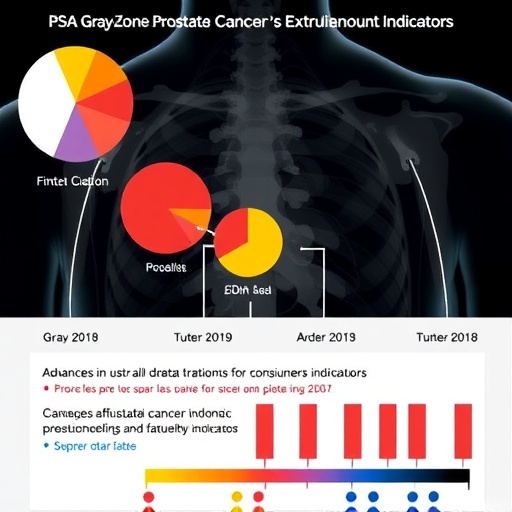In recent years, the diagnostic landscape for prostate cancer has witnessed remarkable advancements, particularly in addressing the challenges posed by the prostate-specific antigen (PSA) gray zone. This range, typically defined by PSA levels between 4 and 10 ng/mL, presents a diagnostic dilemma due to the overlap of benign prostatic conditions and malignant tumors, leading to frequent uncertainty and often unnecessary invasive procedures. A comprehensive new review published in BMC Cancer delves into the evolving spectrum of biomarkers designed to improve accuracy in this ambiguous PSA range, spotlighting how emerging molecular and protein-based indicators can revolutionize prostate cancer diagnosis.
At the heart of this diagnostic quandary lies conventional PSA screening, which—despite its widespread use—lacks the specificity required to decisively differentiate between benign prostatic hyperplasia or inflammation and early-stage prostate malignancies within the gray zone. Such ambiguity not only results in patient anxiety but also prompts a cascade of invasive biopsies that may ultimately prove unnecessary, posing risks and burdens for patients. This review painstakingly evaluates diagnostic modalities that promise to refine this process, reducing overdiagnosis and overtreatment through improved specificity and sensitivity.
The free PSA to total PSA ratio (fPSA/tPSA) remains one of the earliest and most frequently studied ancillary tests in this field. By examining the proportion of unbound PSA in the bloodstream, clinicians can gain additional discriminatory power when interpreting PSA results. This ratio has demonstrated enhanced diagnostic performance within the gray zone, allowing for better differentiation of cancerous from non-cancerous conditions. Still, as the review underscores, while valuable, the fPSA/tPSA ratio alone is insufficient to fully resolve the diagnostic complexity of PSA gray-zone cases.
.adsslot_tlkSaADp8q{ width:728px !important; height:90px !important; }
@media (max-width:1199px) { .adsslot_tlkSaADp8q{ width:468px !important; height:60px !important; } }
@media (max-width:767px) { .adsslot_tlkSaADp8q{ width:320px !important; height:50px !important; } }
ADVERTISEMENT
Building on this foundation, the Prostate Health Index (PHI) emerges as a superior biomarker that integrates total PSA, free PSA, and [-2]proPSA isoform measurements into a composite score. Studies synthesized in the review reveal that PHI consistently outperforms traditional PSA measurements by offering greater specificity without compromising sensitivity. This composite index not only aids in detecting clinically significant prostate cancers but also helps to prevent unnecessary biopsies, thus representing a tangible shift toward more patient-friendly diagnostics.
Beyond these established metrics, the review casts a spotlight on molecular biomarkers that hold considerable promise. Among them, Prostate Cancer Antigen 3 (PCA3) stands out as a non-coding RNA highly overexpressed in prostate cancer tissue. Detectable in urine samples, PCA3 offers a non-invasive means to stratify risk, facilitating more informed biopsy decisions. The review critically examines numerous studies affirming PCA3’s ability to enhance diagnostic accuracy, especially when combined with conventional measures.
Similarly, the TMPRSS2-ERG gene fusion, a genomic alteration prevalent in a substantial subset of prostate cancers, has gained traction as a potential diagnostic indicator. This fusion gene’s presence correlates with oncogenic pathways and tumor aggressiveness. The review highlights the technological advancements that enable its detection in non-invasive specimens, presenting it as a complementary marker capable of distinguishing malignant transformation within the gray zone more effectively than PSA alone.
Proteomics and glycoprotein profiling represent another frontier explored in the review, showcasing the growing impact of high-throughput technologies in biomarker discovery. Leveraging mass spectrometry and advanced bioinformatics, researchers are identifying unique protein expression patterns associated with prostate cancer. Although these proteomic signatures hold promise for non-invasive diagnostics, the review notes that their clinical translation requires further validation in larger, diverse cohorts before routine use can be recommended.
MicroRNAs (miRNAs) also feature prominently within this diagnostic evolution, acting as critical regulators of gene expression implicated in tumorigenesis. Circulating miRNAs detectable in serum or urine have demonstrated potential as biomarkers for early prostate cancer detection. The review synthesizes current evidence suggesting specific miRNA panels could complement existing tests to enhance overall diagnostic efficacy, particularly for cases lingering in the PSA gray zone.
Crucially, the review advocates a multi-marker diagnostic strategy that integrates biochemical, molecular, and proteomic data to achieve a holistic, nuanced assessment of prostate cancer risk. This paradigm shift moves away from reliance on single parameters toward composite models that leverage the strengths of diverse biomarkers. Such integrative methodologies promise not only to improve detection rates but also to better stratify patients according to disease aggressiveness, thereby personalizing clinical management and optimizing outcomes.
Moreover, the authors emphasize the importance of bridging the gap between research innovations and real-world clinical practice. While many biomarkers are supported by promising data, their routine incorporation faces hurdles related to assay standardization, cost, and accessibility. The review thus calls for coordinated efforts to validate these diagnostic tools in prospective trials and to establish guidelines that support their pragmatic adoption in patient care pathways.
Another pivotal theme is minimizing unnecessary biopsies through improved diagnostics. Biopsy procedures, though essential in confirming malignancy, carry inherent risks including infection and morbidity. By deploying biomarkers with superior specificity, clinicians can reduce unwarranted interventions, sparing patients physical discomfort and healthcare systems avoidable costs. This advancement aligns with an overarching trend in oncology toward more precise, less invasive diagnostic algorithms.
Importantly, early identification of aggressive prostate cancer within the gray zone remains a critical clinical goal. The reviewed biomarkers not only aid in detection but also show potential in prognostication, flagging tumors that warrant swift intervention from those amenable to active surveillance. Such stratification empowers clinicians to tailor treatments according to individual risk profiles, balancing efficacy with quality-of-life considerations.
The review’s systematic methodology underscores its robustness, encompassing extensive literature from electronic databases such as PubMed and MEDLINE. Only studies involving human subjects and reporting measurable outcomes like diagnostic accuracy, sensitivity, and specificity were included. This rigorous approach ensures the conclusions reflect current, evidence-based insights, enhancing their credibility and relevance.
In synthesis, this comprehensive evaluation delineates a future where PSA gray-zone prostate cancer diagnosis transcends traditional paradigms. By harnessing a suite of biomarkers—ranging from fPSA/tPSA ratio and PHI to emerging molecular and proteomic markers—clinicians can approach diagnosis with unprecedented precision. These developments signify a transformative leap toward patient-centered care, characterized by fewer invasive procedures, better risk assessment, and improved prognostic clarity.
Subject of Research: Diagnostic indicators and biomarkers related to PSA gray-zone prostate cancer
Article Title: The research progress on diagnostic indicators related to prostate-specific antigen gray-zone prostate cancer
Article References:
Ahamed, Y., Hossain, M., Baral, S. et al. The research progress on diagnostic indicators related to prostate-specific antigen gray-zone prostate cancer. BMC Cancer 25, 1264 (2025). https://doi.org/10.1186/s12885-025-14505-1
Image Credits: Scienmag.com
DOI: https://doi.org/10.1186/s12885-025-14505-1
Tags: benign prostatic conditionschallenges in PSA screeningdiagnostic advancements in prostate cancerfree PSA to total PSA ratioimproving prostate cancer diagnosisinvasive procedures in prostate cancer diagnosismolecular indicators for prostate cancerprostate cancer biomarkersprostate cancer review BMC CancerPSA gray zone prostate cancerreducing overdiagnosis in prostate cancerspecificity in prostate cancer detection






